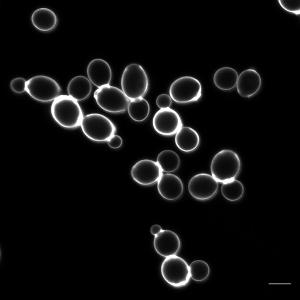
Saccharomyces cerevisiae is the first eukaryote for
which a genome was completely sequenced and it has been studied
intensely as a model organism for decades (1). The physiology and
genetics for this Crabtree positive, non-motile, unicellular yeast
that reproduces by budding are well characterized (7). S.
cerevisiae is used routinely in the baking industry and for
alcohol fermentations. It is generally recognized as safe (GRAS)
and tolerant to a wide range of physiological stresses such as low
pH, high ethanol and high osmotic stress (2). It has gained
wide-spread use as a host for recombinant protein production (5),
pentose utilization capabilities have been developed (2, 4) and
yeast have potential for consolidated bioprocessing (CBP) (3,
6).
The complete sequence of the robust Saccharomyces
cerevisiae strain M3707, isolated from a commercial sample of
distillers yeast, and its tetrads (M3836-M3839) will provide a
useful comparison to the previously sequenced laboratory strain
S288C (SGD).
Genome Reference(s)
Brown SD, Klingeman DM, Johnson CM, Clum A, Aerts A, Salamov A, Sharma A, Zane M, Barry K, Grigoriev IV, Davison BH, Lynd LR, Gilna P, Hau H, Hogsett DA, Froehlich AC
Genome Sequences of Industrially Relevant Saccharomyces cerevisiae Strain M3707, Isolated from a Sample of Distillers Yeast and Four Haploid Derivatives.
Genome Announc. 2013 Jun 27;1(3):. doi: 10.1128/genomeA.00323-13
References
1. Goffeau, A., B. G. Barrell, H. Bussey, R.
W. Davis, B. Dujon, H. Feldmann, F. Galibert, J. D. Hoheisel, C.
Jacq, M. Johnston, E. J. Louis, H. W. Mewes, Y. Murakami, P.
Philippsen, H. Tettelin, and S. G. Oliver. 1996. Life with 6000
genes. Science 274:546-567.
2. Hahn-Hägerdal, B., K. Karhumaa, C.
Fonseca, I. Spencer-Martins, and M. Gorwa-Grauslund. 2007. Towards
industrial pentose-fermenting yeast strains. Appl. Microbiol.
Biotechnol. 74:937-953.
3. Ilmén, M., R. den Haan, E. Brevnova,
J. McBride, E. Wiswall, A. Froehlich, A. Koivula, S. P.
Voutilainen, M. Siika-aho, D. C. la Grange, N. Thorngren, S.
Ahlgren, M. Mellon, K. Deleault, V. Rajgarhia, W. H. van Zyl, and
M. Penttilä. 2011. High level secretion of cellobiohydrolases
by Saccharomyces cerevisiae. Biotechnol. Biofuels 4:30.
4. Kuyper, M., M. M. P. Hartog, M. J. Toirkens,
M. J. H. Almering, A. A. Winkler, J. P. van Dijken, and J. T.
Pronk. 2005. Metabolic engineering of a xylose-isomerase-expressing
Saccharomyces cerevisiae strain for rapid anaerobic xylose
fermentation. FEMS Yeast Res. 5:399-409.
5. Mattanovich, D., P. Branduardi, L. Dato, B.
Gasser, M. Sauer, and D. Porro. 2012. Recombinant Protein
Production in Yeasts. Recombinant Gene Expression, p. 329-358. In
A. Lorence (ed.), vol. 824. Springer New York.
6. Olson, D. G., J. E. McBride, A. J. Shaw, and
L. R. Lynd. 2012. Recent progress in consolidated bioprocessing.
Curr. Opin. Biotechnol. 23:396-405.
7. Sherman, F. 2002. Getting started with yeast,
p. 3-41. In G. Christine and R. F. Gerald (ed.), Methods Enz., vol.
Volume 350. Academic Press.
